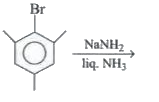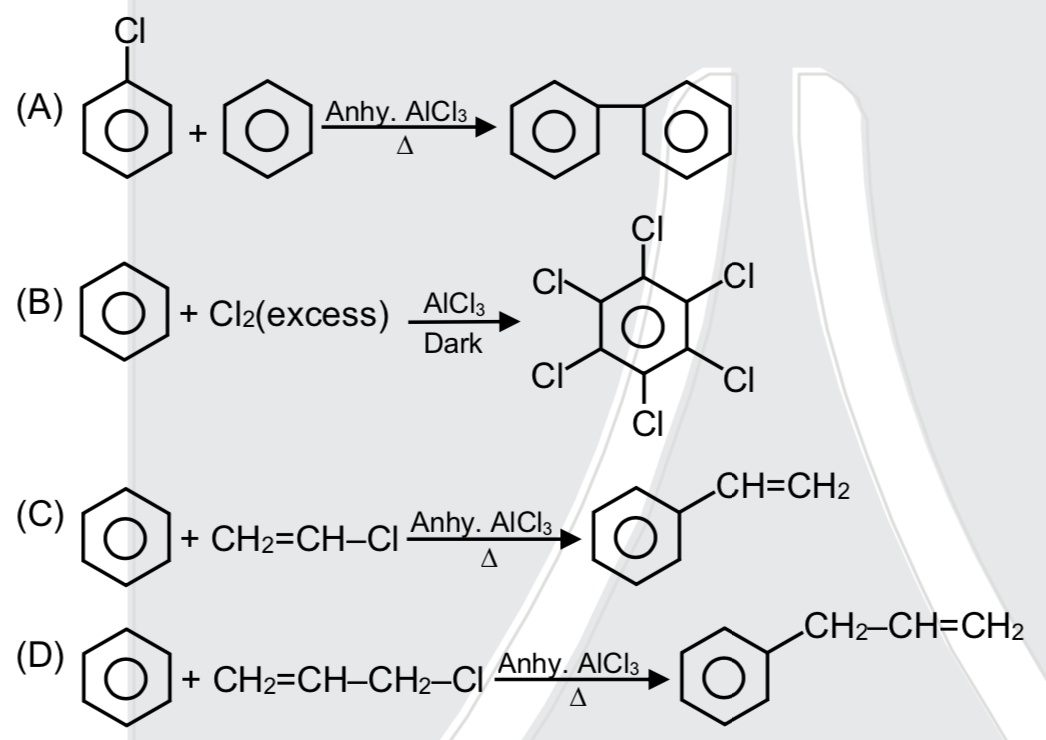Which of the following reactions are both sterospecific and steroselective ?
The correct Answer is:
To determine which reactions are both stereospecific and stereoselective, we need to analyze the characteristics of the reactions in question.
1. Understanding Stereospecificity:
- A reaction is stereospecific if the configuration of the reactant determines the configuration of the product. This means that a specific stereoisomer of the reactant will lead to a specific stereoisomer of the product.
- Example: In an SN2 reaction, the nucleophile attacks from the backside of the leaving group, leading to inversion of configuration.
2. Understanding Stereoselectivity:
- A reaction is stereoselective if it preferentially forms one stereoisomer over others when multiple stereoisomers are possible.
- Example: In an E2 elimination reaction, the base preferentially removes the more stable β-hydrogen, leading to the formation of the more stable alkene (Zaitsev's rule).
3. Analyzing SN2 Reaction:
- SN2 reactions are both stereospecific and stereoselective. The nucleophile attacks from the opposite side of the leaving group, leading to inversion of configuration (stereospecific). Additionally, if there are multiple possible products, the reaction will favor the formation of one stereoisomer (stereoselective).
4. Analyzing E2 Reaction:
- E2 reactions are also both stereospecific and stereoselective. The base removes a specific β-hydrogen, leading to the formation of a particular alkene (stereospecific). Furthermore, the reaction tends to form the more stable alkene product (stereoselective).
5. Conclusion:
- Based on the analysis, both SN2 and E2 reactions exhibit characteristics of being stereospecific and stereoselective. Therefore, the correct answers are the reactions corresponding to SN2 and E2.
Final Answer:
The reactions that are both stereospecific and stereoselective are SN2 and E2.
- A reaction is stereospecific if the configuration of the reactant determines the configuration of the product. This means that a specific stereoisomer of the reactant will lead to a specific stereoisomer of the product.
- Example: In an SN2 reaction, the nucleophile attacks from the backside of the leaving group, leading to inversion of configuration.
- A reaction is stereoselective if it preferentially forms one stereoisomer over others when multiple stereoisomers are possible.
- Example: In an E2 elimination reaction, the base preferentially removes the more stable β-hydrogen, leading to the formation of the more stable alkene (Zaitsev's rule).
- SN2 reactions are both stereospecific and stereoselective. The nucleophile attacks from the opposite side of the leaving group, leading to inversion of configuration (stereospecific). Additionally, if there are multiple possible products, the reaction will favor the formation of one stereoisomer (stereoselective).
- E2 reactions are also both stereospecific and stereoselective. The base removes a specific β-hydrogen, leading to the formation of a particular alkene (stereospecific). Furthermore, the reaction tends to form the more stable alkene product (stereoselective).
- Based on the analysis, both SN2 and E2 reactions exhibit characteristics of being stereospecific and stereoselective. Therefore, the correct answers are the reactions corresponding to SN2 and E2.
The reactions that are both stereospecific and stereoselective are SN2 and E2.
Topper's Solved these Questions
- AROMATIC COMPOUNDS AND ALKYL AND ARYL HALIDES Book:CENGAGE CHEMISTRY ENGLISHChapter:AROMATIC COMPOUNDS AND ALKYL AND ARYL HALIDES Exercise:Exercises Multiple Correct Answers Type
Explore 15 Videos
- AROMATIC COMPOUNDS AND ALKYL AND ARYL HALIDES Book:CENGAGE CHEMISTRY ENGLISHChapter:AROMATIC COMPOUNDS AND ALKYL AND ARYL HALIDES Exercise:Exercises Single Correct Answer Type
Explore 28 Videos
- AROMATIC COMPOUNDS AND ALKYL AND ARYL HALIDES Book:CENGAGE CHEMISTRY ENGLISHChapter:AROMATIC COMPOUNDS AND ALKYL AND ARYL HALIDES Exercise:Exercises Linked Compreshension Type
Explore 11 Videos
- APPENDIX INORGANIC VOLUME 2Book:CENGAGE CHEMISTRY ENGLISHChapter:APPENDIX INORGANIC VOLUME 2Exercise:Short Answer Type
Explore 179 Videos
- BIOMOLECULESBook:CENGAGE CHEMISTRY ENGLISHChapter:BIOMOLECULESExercise:Exercises Archives (Analytical And Descriptive)
Explore 8 Videos
Similar Questions
Knowledge Check
Which of the following reactions are not feasible?
A B
B C
C D
D
Which of the following reaction is possible ?
AC6H5OH+HBr→C6H5Br+H2OB(CH3)3CCl+NaOCH3→(CH3)3COCH3+NaClC D
D
Which of the following reactions are possible ?

View SolutionWhich of the following reactions are possible ?

View SolutionWhich of the following reaction(s) is/are neither sterospecific nor steroselective?
View SolutionWhich of the following reactions(s) is/are both non-sterospecific but steroselective ?
View SolutionWhich of the following reaction is endothermic?
View SolutionWhich of the following reactions(s) is/are sterospecific but non-steroselcetive?
View Solution